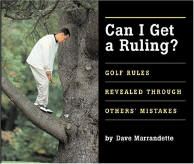Can I Get a Ruling? Golf Rules Revealed Through Others’ Mistakes
It’s not easy to find ways to convince folks to do what’s good for them.
For example, as a child watching Saturday morning television (a very long time ago), I frequently watched a commercial for a maple-flavored oatmeal. If I recall correctly, the ad would show a parent waving a spoonful in front of a child as if it was an airplane, singing something like “Mrowwn, maple-flavored, mrowwn–Maypo!” The oatmeal-laden spoon would then “land” right in the child’s mouth.
Dave Marrandette’s Can I Get A Ruling? reminded me of this old advertisement—but in a good way.
In both instances the creators are trying to convince potentially unwilling participants to do something they might not like. In the child’s case, it was eating something nutritious. In Marrandette’s case, it’s the recurring problem of generating interest in learning and applying the Rules of Golf.
Fortunately, Marrandette’s methods should be helpful to a lot of golfers. Instead of a dry description of the Rules and how they work, he uses the power of parables.
There’s nothing like a colorful anecdote to show how a rule works, and there are plenty of examples from the professional golf tours to cover the typical incidents.
Here’s one from the chapter, “How do you spell R-E-L-I-E-F?”
Chip Beck hit near an out-of-bounds stake, and without skipping a beat removed the stake to clear the area for his next shot. Almost immediately he realized his mistake, but the damage was done, adding two penalty strokes to his score. Marrandette uses this story from the 1992 Greater Greensboro Open to cover the movable obstruction rules (it’s not), and also points out that the error cost Beck $81,563 in prize money.
I assume Beck hasn’t touched a boundary stake ever since.
Most of the chapters in this slender, easily-read book cover a single basic part of the Rules, fleshed out with several stories taken from events of the last fifty years or so. Several of these yarns will be familiar to long-time golf fans, but Marrandette manages to keep them fresh in the re-telling.
In addition, he explains how some of the rules have evolved, in part to address fairness or competition issues caused in part by the prior drafts.
For example, the chapter on time includes several instances in putting, where the ball hangs on the lip of the hole. The current 10-second time limit included a loss-of-hole penalty for match play and a two-stroke penalty for medal play when it was first instituted in 1984.
Four years later the penalties were reduced to a single stroke, but this easy-to-understand rule can still be a bit tricky to apply. Marrandette recounts the Lee Janzen incident in the 1998 NEC World Series of Golf to prove this point.
Marrandette also discusses not only the how of the Rules, but also the why.
The geography of golf, spread out over 120 acres or more, requires the players to police their own conduct to an extent not seen in nearly any other sport, especially at the professional level. The Rules act as a code of golfing ethics to which all players usually adhere, which helps keep at bay the Hobbesian alternative (otherwise, the game would be nasty, brutish, and short).
This distinction from other sports is most stark in the game’s requirement for players to call penalties on themselves, no matter what the consequences.
In addition to citing several stirring examples of this ethical conduct from the professional ranks, Marrandette also gives a few instances from amateur competition.
I especially appreciated two stories from high school golf in Massachusetts and Florida. The examples these young players set were in the best tradition of sportsmanship, and their stories deserve a wide audience.
This is a well-done book about a potentially dry part of the game of golf. High school and college golf coaches should find a way to have their players read it before the start of every season.
If nothing else, they’ll be tickled by the great cover photograph of a golfer trying to chip a ball from the nook of a tree branch, while standing on the branch itself. That scene alone might help convince them to open up the book.
Review date: January 24, 2005


